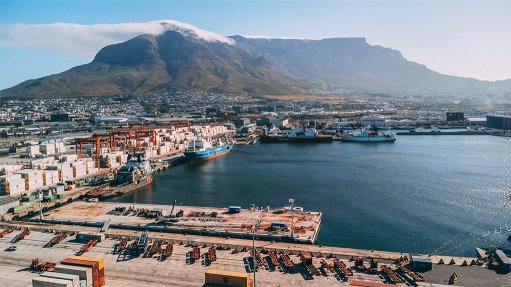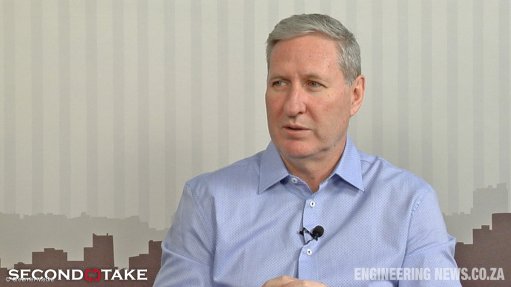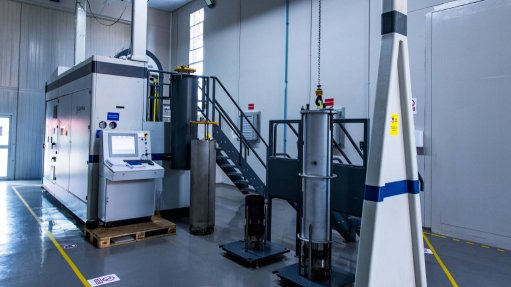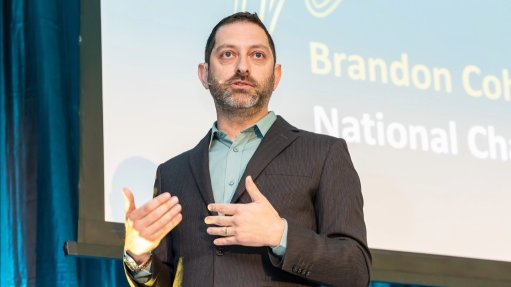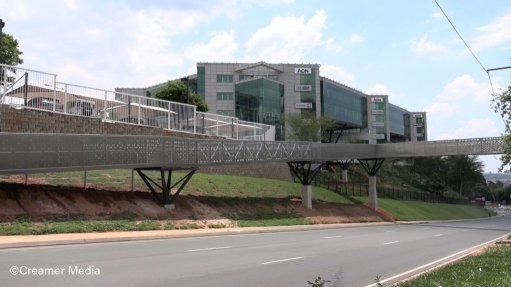Reserve clears invasive species, aids biomass production

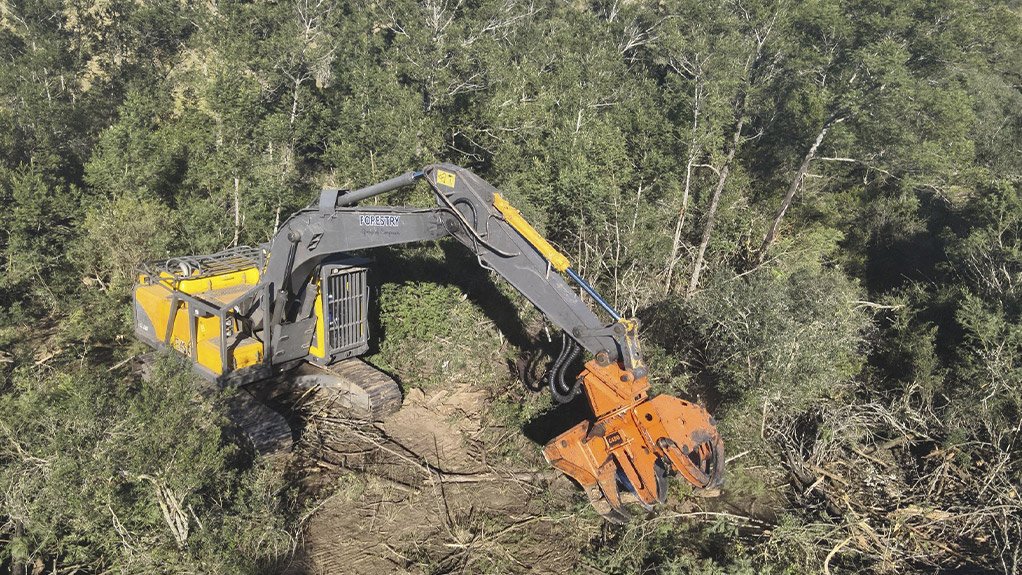
CLOSE ENCOUNTERS OF THE TREE KIND A mechanised system comprising an excavator-based felling head, grapple skidder and full tree chipper is being used to remove the invasive species
Black wattle trees, an invasive species, outcompete native plant species, thereby reducing biodiversity and significantly impacting on water resources, which is why Eastern-Cape-based wildlife reserve Lalibela approached the Coega Biomass Centre (CBC) for a mutually-beneficial solution.
Black wattle, Acacia mearnsii, is an invasive species that arrived in South Africa from Australasia. A single adult tree can absorb up to 40 ℓ/d of underground water, and the plants spread rapidly. According to the National Environmental Management Biodiversity Act and the Alien and Invasive Species Regulations, landowners are legally required to manage these species.
Meanwhile, the CBC produces wood pellets made from 100% invasive alien plants, offering a sustainable, high-efficiency biomass solution.
The partnership resulted from the sheer scale of invasive wattle on the reserve’s land, as well as CBC’s sustainability credentials, which appealed to Lalibela.
“Given Lalibela’s commitment to effective environmental management and the implementation of strategic restoration practices across its landscape, the decision to partner with CBC was both appropriate and advantageous. CBC’s operational approach aligns with our conservation ethos, prioritising the protection of indigenous forests, minimising disturbance to surrounding natural vegetation and promoting the sustainable and environmentally responsible use of harvested materials. Its emphasis on ecological sensitivity and circular resource use further supports global environmental sustainability objectives,” says Lalibela CEO Johann Lombard.
He explains that the stand of black wattle at Lalibela was so extensive that removal would take the reserve’s in-house team between two and four years. Beyond the logistical constraints, the wattle posed significant ecological threats, including the displacement of native flora, alteration of fire regimes and degradation of soil quality and water availability. The “timely and systematic removal” of the wattle was thus essential to restoring ecological balance in support of the reserve’s long-term conservation objectives.
Moreover, Lombard notes that “disturbed areas are prone to even faster regrowth, which requires multiple rounds of follow-up clearing. Once cut, the branches must be either air-dried or processed through a woodchipper”.
He points out that all these processes are labour-intensive and costly and that CBC’s machinery, qualified staff and equipment helped better facilitate a mass-scale eradication of well-established black wattle.
In terms of why the wattle was so widely dispersed, Lombard explains that the reserve “bears the legacy of pre-reserve agricultural practices”, noting that black wattle was deliberately introduced to supply tannin for leather processing.
“The lack of understanding of its invasive potential ensured that black wattle proliferated unchecked—particularly in riparian and valley systems where elevated soil moisture facilitated rapid growth. Over time, a substantial persistent seed bank accumulated within the soil profile.” Moreover, intermittent wildfires—both within and adjacent to the reserve – catalysed the emergence of dense wattle thickets, which expanded progressively under favourable rainfall regimes. “Collectively, these factors have driven the species’ aggressive colonisation and underscore the necessity for systematic removal to restore native ecosystem dynamics.”
Fortunately, the harvesting and clearing process at the reserve, which started in May, is progressing at about 1 ha each day, and the black wattle that has been cleared is being repurposed into sustainable biomass fuel.
CBC notes that, to manage the risk of negative wildlife-human interaction, a mechanised system comprising an excavator-based felling head, grapple skidder and full tree chipper is being used on the site.
Further, the material is chipped onsite in the interest of efficiency – given the size and type of plant species being removed – and, thereafter, the wood chips are transported to CBC’s facility, where they are turned into pellets.
CBC explains that the wattle chips form part of a blend of species to create a certain standard and type of pellet. No other additives are used in the manufacturing process.
These pellets reportedly deliver up to 70% CO₂ savings compared with coal, but nonetheless boast high calorific values and low moisture content, which ensures efficient combustion for industrial and energy applications. The biomass pellets align with standards set out by the International Organisation for Standardisation, specifically by ISO 17225-2, and are certified by the Sustainable Biomass Program and Forest Stewardship Council.
CBC’s work not only helps to improve biodiversity and water conservation, it also creates jobs in rural communities and supports South Africa’s goals for a just and sustainable energy transition. Further, its pellet solutions offer significant cost advantages compared with fossil-based boiler fuels such as heavy fuel oil, heating oil, liquefied petroleum gas, and paraffin.
“We have the same end-goal at heart,” says Lombard: “A renewable resource that helps eradicate invasive species, while working toward a pristine environment where native wildlife, including endangered species, can thrive.”
He notes that, based on previous experience, visible improvements in the cleared region are imminent.
“Following the removal of black wattle in other areas of the reserve, grassland savannah has quickly taken root, underground water is more available to local river systems, streams and marshes, and biodiversity has returned, particularly for grazers like zebra, wildebeest and antelope, which rely on open grasslands.”
Lombard notes that Lalibela currently boasts one of the highest carrying capacities – the maximum number of animals that a specific area can support indefinitely without causing environmental degradation or resource depletion – in the Eastern Cape based on the extensive grasslands that have formed where wattle used to grow.
He adds that, while Lalibela currently does not use biomass for its energy needs, as biomass technologies advance, the reserve will evaluate and potentially integrate this renewable-energy source into its infrastructure.
CBC, meanwhile, notes that the local biomass industry is “slowly gaining traction in South Africa, both on the production and the use side”. The company adds that, at present, it is still partially reliant on its export markets, given the nascent nature of the biomass sector.
However, events such as Africa's leading environmental trade fair IFAT Africa, which is taking place from July 8 to 10, and its global network of trade events can help bolster the bioenergy industry, and attendees can benefit from interactions and engagements with related associations, industry players and potential trade partners.
Article Enquiry
Email Article
Save Article
Feedback
To advertise email advertising@creamermedia.co.za or click here
Comments
Press Office
Announcements
What's On
Subscribe to improve your user experience...
Option 1 (equivalent of R125 a month):
Receive a weekly copy of Creamer Media's Engineering News & Mining Weekly magazine
(print copy for those in South Africa and e-magazine for those outside of South Africa)
Receive daily email newsletters
Access to full search results
Access archive of magazine back copies
Access to Projects in Progress
Access to ONE Research Report of your choice in PDF format
Option 2 (equivalent of R375 a month):
All benefits from Option 1
PLUS
Access to Creamer Media's Research Channel Africa for ALL Research Reports, in PDF format, on various industrial and mining sectors
including Electricity; Water; Energy Transition; Hydrogen; Roads, Rail and Ports; Coal; Gold; Platinum; Battery Metals; etc.
Already a subscriber?
Forgotten your password?
Receive weekly copy of Creamer Media's Engineering News & Mining Weekly magazine (print copy for those in South Africa and e-magazine for those outside of South Africa)
➕
Recieve daily email newsletters
➕
Access to full search results
➕
Access archive of magazine back copies
➕
Access to Projects in Progress
➕
Access to ONE Research Report of your choice in PDF format
RESEARCH CHANNEL AFRICA
R4500 (equivalent of R375 a month)
SUBSCRIBEAll benefits from Option 1
➕
Access to Creamer Media's Research Channel Africa for ALL Research Reports on various industrial and mining sectors, in PDF format, including on:
Electricity
➕
Water
➕
Energy Transition
➕
Hydrogen
➕
Roads, Rail and Ports
➕
Coal
➕
Gold
➕
Platinum
➕
Battery Metals
➕
etc.
Receive all benefits from Option 1 or Option 2 delivered to numerous people at your company
➕
Multiple User names and Passwords for simultaneous log-ins
➕
Intranet integration access to all in your organisation








